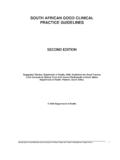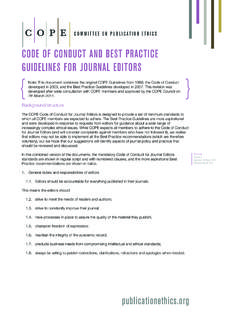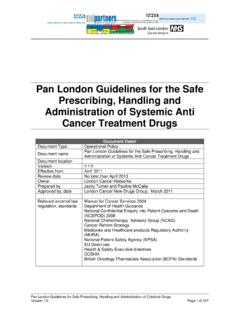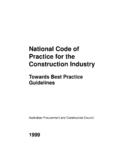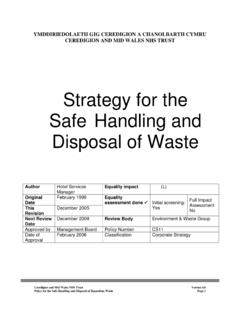Transcription of Tech Guide on LNG Bunker Vessels and Barges 10Sept15
1 1 2015 American Bureau of Shipping. All rights Guidance onLNG Bunker Vessels & BargesStavros NiotisSenior Engineer, Piraeus tech & Business DevelopmentHamburg, Germany10 September 2015 ICST Congress 20152 ConfidentialBunkering Scenarios23 ConfidentialContent What is an LNG Bunker vessel or Barge? Applicable Standards, Regulations and Guides Cargo Containment Systems Overview of Cargo / Discharge Operations Bunkering Operations Safety Considerations andPersonnel Training4 ConfidentialWhat is an LNG Bunker vessel ?Self-propelled Bunker Vessels are considered LNG carriers A1, Liquefied Gas Carrier Rule Sets ABS Rules for Building and Classing Steel Vessels (Jan. 2015)SOURCE:AGA Presentation at Stockholm-Turku Conference 11 Sept.
2 201335 ConfidentialWhat is an LNG Bunker Barge? Bunker Barges are considered LNG Barges A1, Liquefied Gas Tank Barge Rule Sets ABS Rules for Building and Classing Steel Barges (Jan. 2015)Source: is an LNG Bunker vessel ?As far as the LNG activities are concerned EMSA uses the following classification:This presentation will mainly cover Small-Scale LNG Bunker vessels47 ConfidentialContent What is an LNG Bunker vessel or Barge? Applicable Standards, Regulations and Guides Cargo Containment Systems Overview of Cargo / Discharge Operations Bunkering Operations Safety Considerations andPersonnel Training8 ConfidentialApplicability to Bunkering Vessels For Liquefied Gas Carriers or Liquefied Gas Tank Barge IMO International Gas Code (IGC) Note.
3 New IGC to enter into forcefor Vessels with keel laying after 1 January 2016 vessel interface with gas fueled ships should be considered and IGF code may be required by the flag Administration59 ConfidentialABS Guide for Dual Fueled Vessels ABS has published on May 2011 and last updated on May 2015 a Guide for Propulsion and Auxiliary Systems for Gas Fueled Ships Section 4 of this Guide covers Fuel Gas Bunkering Systems This Section can be taken as a reference also for the design of the bunkering vessels10 ConfidentialBunker Station Requirements No gas is to be discharged to air during bunkering operations Key Bunker station requirements Sufficient natural ventilation Physical separation and structural protection Stainless steel drip trays Class A-60 protection Vapour return line provision Manifold filters Manual and remote ESD valves ESD valve closing speedSource.
4 Wartsila611 ConfidentialBunker Station Requirements Key Bunker station requirements ESD and bonding connections Remote control and monitoring Local pressure gauges Draining/purging/inerting provision Gas detection of enclosed or semi enclosed Bunker stations Ventilation and gas detection of enclosed bunkering lines Fixed fire detection and extinguishing systemCONTROL STATIONLNG SUPPLYVAPOR RETURNCOMM LINK/ESDBONDING CONNECTIONGas detection and ventilation for enclosed or semi enclosed stationStop valve and ESD valveDrip trays and means of drainage to be provided12 ConfidentialABS Technology Initiatives on Bunkering ABS is preparing a new Guide for Remote Control and Monitoring and Systems on Barge Installations Other on-going initiative of ABS Technology are studies on: Parametric motion simulation of ship-to-ship LNG fuel bunkering Various projects on containment systems Cumulative fatigue analysis Longevity New generation Sloshing BOR estimation713 ConfidentialContent What is an LNG Bunker vessel or Barge?
5 Applicable Standards, Regulations and Guides Cargo Containment Systems Overview of Cargo / Discharge Operations Bunkering Operations Safety Considerations andPersonnel Training14 ConfidentialType Ap < 700 mbarFull Secondary barrierSpherical (Moss) Prismatic (IHI SPB) .Type Bp < 700 mbarPartial Secondary barrierCylindricalBilobeType Cp > 2000 mbarNo Secondary barrierIndependent TanksGTT No 96 GTT Mark IIIO ther Systems:Membrane Tanksp < 700 mbarFull Secondary barrierIntegrated tanksIMO IGC Classification of Containment systemsSources: Moss Maritime, IHI, TGE, GTTB ased on classical ship structure design rulesBased on first-principle analysis and model tests Leak Before Failure Pressure Vessels , based on pressure vessel code- GTT MARK V- KOGAS KC-1- SHI SCA-WS- HHI LNG Membrane- DSME MembraneNone in operationNew systems under development.
6 - Aker ADBT- LNT A-Box- Torgy815 ConfidentialTank Types on LNG Carriers Membrane Type Type B Tanks Type C tanks / Bilobe TanksBy courtesy of GTTBy courtesy of TGE16 ConfidentialNew Cargo Containment Systems? LNT A-Box IMO type A tank Complete double hull Independent type A tank located in the holds Insulation arranged on the internal surface of the inner hull of the vessel Secondary barrier membrane on top of insulationBy Courtesy of LNT917 ConfidentialKey Factors on Selecting Tank Type Design Pressure vessel s operational profile BOG handling equipment requirements Volume space efficiency (ship s main dimensions) Secondary barrier inerting requirements Additional equipment Operators skills Filling limits restrictions (sloshing) Loading limits restrictions (design pressure) Design and building specialized workforce (availability of shipyards / builders)
7 Cost 18 ConfidentialLNG Bunker Vessels The Seagas is the only LNG bunkering vessel currently in operation serving seagoing Vessels Converted ferry IGC Code Type C tank 187m3 No vapor return Pressure decant Other concepts/projects Conrad Shipyard project White Smoke Wilhemsen Kawasaki Argos Oil LNG membrane tanks 2x935m3and MGO Inland LNG carrier 2250m31019 ConfidentialLNG Bunker Barge Designs Elliott Bay Design Group ABS AIP 2000 m3 LNG America Jensen Maritime Design ABS AIP Mercury 1000 m3 Gemini 3000 m3 Photo Source: Jensen Maritime Consultants / LNG America / World Maritime News20 ConfidentialArgent Marine Bunker BargeCourtesy: Argent Marine1121 ConfidentialConrad to Build First LNG Bunker Barge in NA(February 2015) Serve TOTE's Orca-class RO-ROs and Marlin-class containerships 2,200 cubic meter (cbm) barge Expected delivery in early 2016; ABS Class Deployed in Tacoma (Washington State) 1 MARK III Flex tank (GTT - Gaztransport & Technigaz) Bristol Harbor Group Inc.
8 DesignPhoto Source: Professional Mariner22 ConfidentialApproval-In-Principle (AIP) General scope of review: General arrangement Engine selection Gas system equipment selection Hazardous areas plan LNG fuel containment type Tank location and supporting structure Fuel gas and ventilation systems routing plan Bunkering operation philosophy1223 ConfidentialContent What is an LNG Bunker vessel or Barge? Applicable Standards, Regulations and Guides Cargo Containment Systems Overview of Cargo / Discharge Operations Bunkering Operations Safety Systems andPersonnel Training24 ConfidentialPreparing Cargo Tank after DrydockingAeration (dry air)Inerting (dry IG)Gassing up Notes: Aeration/Inertingdew point to be kept below 45 C1325 ConfidentialCooling Down Prior to Loading Notes: Cooling down process generates boil off To be sent back to shore, vented or burned26 ConfidentialLoading & Unloading Notes: Loading/unloading can be performed with or without vapour return If no vapour return is used.
9 The discharging ship will need to generate vapour to avoid vacuum The loading ship must control the tank pressure through use of sprayLOADING1427 ConfidentialPreparing Cargo Tank before DrydockingWarming upInertingAerationNotes: Warming up process will generate boil off gas. To be sent to shore or burned28 ConfidentialContent What is an LNG Bunker vessel or Barge? Applicable Standards, Regulations and Guides Cargo Containment Systems Overview of Cargo / Discharge Operations Bunkering Operations Safety Considerations andPersonnel Training1529 ConfidentialMain Components Transfer systems Cryogenic composite hoses Mechanical cryogenic arms Hybrid systems with hose manipulators Quick couplings/ dry-break couplingsCourtesy.
10 GTTNA30 ConfidentialFuel Transfer GTT REACH4 (Refueling Equipment Arm, Methane [CH4]) Ensures simple and safe transfer of LNG fuel to the client vessel Features break-away couplings for safe and reliable emergency disconnections Patented configuration prevents rapid disconnections and keeps the breakaway couplings in a fixed position on the mast to ensure simple and safe deploymentSources: / GTT1631 ConfidentialLNG Transfer Systems Loading rates Local requirements Exclusion zones Hazardous area, safety zone, security zone Simultaneous operations Firefighting requirements Environmental issues Fuel delivery measurements Quantity Gas properties32 ConfidentialIndustry Experience with STS LNG Transfer LNG STS transfer is now common practice, for several FSRU projects SIGTTO/OCIMF STS bunkering Guide developed leveraging on the existing experience LNG bunkering barge operating in SwedenSOURCE: Stockholm-Turku Conference 11 Sept.

